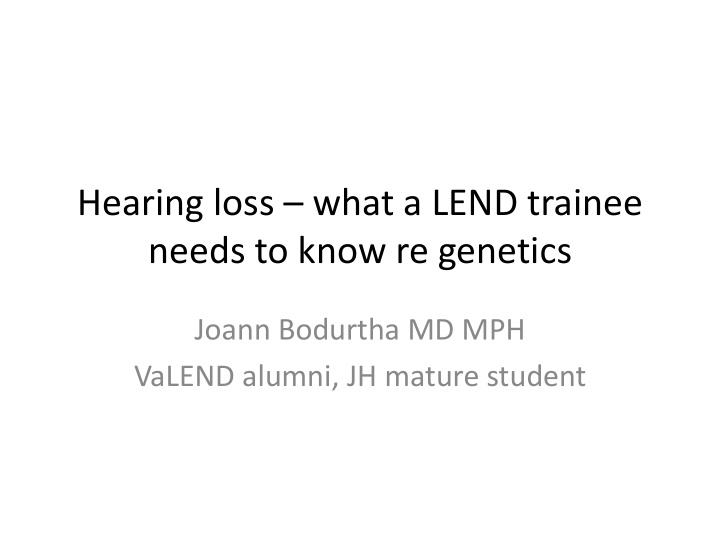



Hearing loss – what a LEND trainee needs to know re genetics Joann Bodurtha MD MPH VaLEND alumni, JH mature student
Prevalence • ~1 in 500 children are born with congenital HL or develop severe-profound HL in early childhood (~8000 children in US annually) • 50-60% of congenital HL is genetic – Of genetic, ~70% non-syndromic; 30% syndromic – Of non-syndromic, connexin 26 mutations (GBJ2 gene contains instructions for a cochlear protein) account for ~40% of congenital HL • ~25% environmental (e.g. CMV, hemorrhage, aminoglycosides)
Branchio-oto-renal syndrome • AD • underdeveloped kidneys • preauricular pits/tags • outer and middle ear malformations • neck fistulas • EYA1 developmental gene change
CHARGE syndrome • Coloboma • heart anomalies • atresia choanae • retardation of growth • genital/kidney • ear anomalies • 2/3 with CHD7 gene change (helicase – binding)
Stickler syndrome • AD • flat face • Pierre Robin • HL • Myopia • hypermobility with early arthritis • collagen changes
Treacher Collins syndrome • AD • downslanted eyes • ear-cheek-eye anomalies • HL • TCOF1 changes lead to reduced number of neural crest cells forming craniofacial anomalies
Waardenburg syndrome • AD • HL • iris pigment changes • hypopigmentation • distinctive face • multiple genes
HL Checklist • HL • Aminoglycoside exposure • Arrthymias (fainting, seizures) • Blindness (RP, retinal detachment, high myopia) • Cleft palate • Ear tags, pits • Congenital infection, brain hemorrhage • Pigment changes (2-color eyes, white forelock, early graying, piebald) • Prematurity • Skeletal alterations (early arthritis) • Other notable findings
Resources • American Speech-Language-Hearing Association www.asha.org • Deafness and hereditary hearing loss – overview www.ncbi.nlm.nih.gov/books/NBK1434 • http://www.cdc.gov/ncbddd/hearingloss/freemat erials/ParentsGuide508.pdf • HeriditaryHearingLoss.org • National Institute on Deafness and Other Communication www.nidcd.nih.gov
Recommend
More recommend